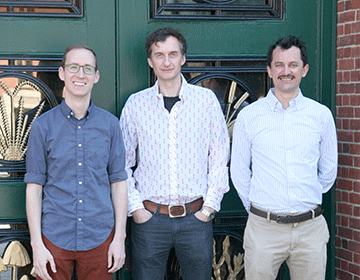The Engert and Schier labs address in a recent paper in Neuron (PDF) how larval zebrafish senses temperature and transforms the sensory representation to generate behavior with the ultimate…
Tag: Alexander Schier
E Pluribus Unum: One Brain from Many Cells [Schier Lab]
In papers in Nature Biotechnology and Current Biology, the Schier lab reports how thousands of single-cell transcriptomes can be used to define cell types and reconstruct lineage relationships…
The Intricacies of Embryonic Signaling [Schier Lab]
In three papers in eLife, the Schier lab provides surprising insights into the regulation of early vertebrate embryogenesis. Focusing on the roles of the TGF-b Nodal signaling pathway,…
CRISPR CELL LINEAGES [SCHIER LAB]
The cells in a multicellular organism develop via a lineage that starts with the fertilized egg. Lineage trees describe the divisions and specializations of cells over time, as…
HOW DO ZEBRAFISH PERCEIVE HEAT? [ENGERT AND SCHIER LABS]
(l to r) Alex Schier, Martin Haesemeyer and Florian Engert As we explore our environment we constantly experience new sensations – changes in the visual scene, different sounds…
MAPPING ACTIVITY AND ANATOMY IN THE ZEBRAFISH BRAIN [ENGERT AND SCHIER LABS]
The holy grail for neuroscientists is to understand how the symphony of activity in our 100 billion neurons acts to control our thoughts and actions. The NIH BRAIN…
POSTDOC PROFILE: ANDI PAULI [SCHIER LAB]
If you ask Andrea Pauli, she’ll tell you she got lucky—that her scientific career has been a domino effect of coincidence and good fortune. An abrupt relocation, a…
WIRED TO ESCAPE [SCHIER AND ENGERT LABS]
(l) Alex Schier, and Alix Lacoste Knock on a tank of fish and you may observe that the animals suddenly change position. Blink, and you missed it. When…
THE WHERE AND WHY OF GENE EXPRESSION [SCHIER LAB]
(l to r) Jeff Farrell, Alex Schier, and Julien Dubrulle While most cells in the body have the same DNA, and thus the same set of genes, cells…
MIDDLE SCHOOL STUDENTS BECOME SCIENTISTS FOR A DAY IN MCB
Alex Schier and Tessa Montague shown here with the students from the Mott Hall Bridges Academy in Brooklyn, NY During the first week of April, middle school students…











